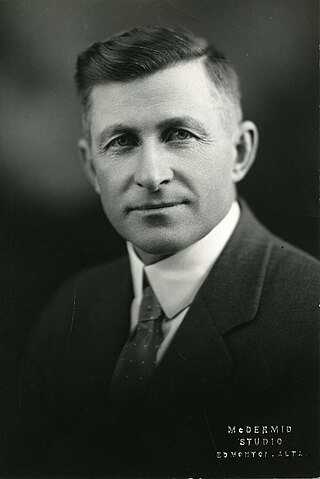
The Northwest Territories Legislative Assembly, or Legislative Council of the Northwest Territories, is the legislature and the seat of government of Northwest Territories in Canada. It is a unicameral elected body that creates and amends law in the Northwest Territories. Permanently located in Yellowknife since 1993, the assembly was founded in 1870 and became active in 1872 with the first appointments from the Government of Canada.

Medicine Hat was a provincial electoral district in Alberta, Canada, mandated to return members to the Legislative Assembly of Alberta from 1905 to 1971, and again from 1979 to 2019. The electoral district was named after the City of Medicine Hat.

Francis Austin Walker was a Canadian politician who served as a member of the Legislative Assembly of Alberta from 1905 until 1921. Born in Lucan, Ontario, on November 17, 1871, he moved west to Alberta, becoming a pioneer in the area east of Edmonton.
Banff was a provincial electoral district in Alberta, Canada, mandated to return a single member to the Legislative Assembly of Alberta using the first past the post method of voting from 1905 to 1909, and again from 1975 to 1979.
Lethbridge was a provincial electoral district in Alberta mandated to return a single member to the Legislative Assembly of Alberta from 1905 to 1909, and again from 1921 to 1971.

The 1902 North-West Territories general election, occurred on 21 May 1902 and was the fifth general election in the history of the North-West Territories, Canada. It was held to elect 35 Members of the Legislative Assembly of the North-West Territories.
The 1888 North-West Territories general election elected members of the 2nd Legislative Council of the North-West Territories. The 2nd Legislative Council of the North-West Territories replaced the 1st Council of the North-West Territories. The 2nd Legislative Council of the North-West Territories was replaced by the 1st North-West Assembly in 1891 when the quota of elected members was reached.
The North-West Territories Liberal Party was a short-lived branch of the Liberal Party of Canada in the North-West Territories.
Vegreville was a provincial electoral district in Alberta, Canada, mandated to return a single member to the Legislative Assembly of Alberta from 1909 to 1963 and again from 1971 to 1993.
Innisfail was a provincial electoral district in Alberta, Canada, mandated to return a single member to the Legislative Assembly of Alberta from 1905 to 1940 and again from 1971 to 1993.
Wetaskiwin was a provincial electoral district in Alberta, Canada, mandated to return a single member to the Legislative Assembly of Alberta from 1905 to 1971.

Charles Wellington Fisher was a Canadian politician who served as the first Speaker of the Legislative Assembly of Alberta.

Rudolph Hennig was a politician from Alberta, Canada. He served in the Legislative Assembly of Alberta from 1926 to 1935 as a member of the United Farmers of Alberta.

Peter Alexander Miskew was a politician and lawyer from Alberta, Canada. He served as a member of the Legislative Assembly of Alberta from 1930 to 1935 sitting with the United Farmers caucus in government and also with the Liberal caucus in opposition.
Victoria was a former territorial electoral district that was mandated to return a single member to the North-West Legislative Assembly from 1894 until Alberta became a province in 1905.
High River was a provincial electoral district in Alberta mandated to return a single member to the Legislative Assembly of Alberta from 1905 to 1930.
John "Jack" WilliamShera was a Canadian politician who served as a Member of the North-West Legislative Assembly from 1898 until 1905, representing the district of Victoria in what is now eastern Alberta.
Frank Fraser Tims was a Canadian politician. He served on the North-West Legislative Assembly for Victoria from 1894 to 1898.






